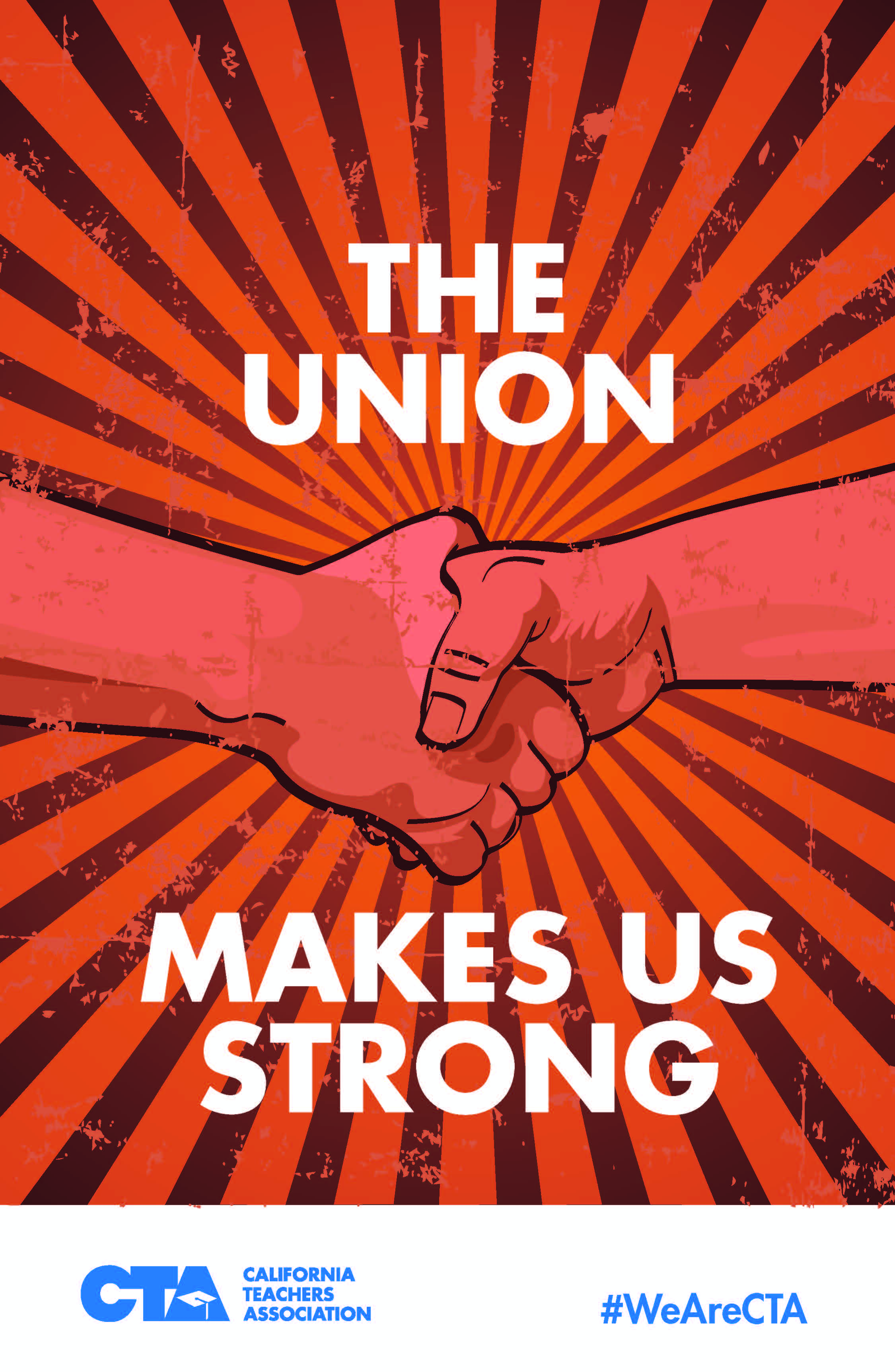Propaganda posters in California public school classrooms: union dogma or educational opportunity?
Why is the California teachers union Association distributing political propaganda posters to teachers and other educators for display “in your school, classroom, and beyond?”
The California Teachers Association doesn’t offer teachers a guide for the use of these posters in classroom instruction. Nor does it recommend the posters as catalysts for students to think about the nature and purpose of government. Instead, the posters have been presented at union conferences and on the union website with an associated “Social Justice Toolkit” for political advocacy.
It’s obvious these posters are meant to advance an ideology rather than encourage classroom discussion. And from the perspective of the California Teachers Association, is there any valid discussion to be had about the righteousness of “Social Justice?” The California Teachers Association seemingly regards its posters as declarations of self-evident truths for students to absorb and adopt. Any questioning of the messages on the posters is probably a trick by the ruling class to suppress social justice and maintain its power.
But suppose some teachers wanted to use these posters as an instructional tool rather than as a proclamation of union dogma. Students could practice critical thinking and consider diverse perspectives on controversial issues. Here are three questions related to the posters that could inspire critical thinking among students.
1. Are the statements on the California Teachers Association posters irrefutable truths?
As Thomas Jefferson in his time and place identified self-evident truths within the Declaration of Independence, the California Teachers Association has identified self-evident truths in this time and place. Before considering the statements on the posters, students could have a meaningful classroom discussion about whether the following statement contains truths that don’t need proof:
We hold these Truths to be self-evident, that all men are created equal, that they are endowed by their Creator with certain unalienable Rights, that among these are Life, Liberty and the pursuit of Happiness.
The California Teachers Association uses a different epistemological system to perceive and pronounce its own set of self-evident truths in the posters. And, as with Jefferson’s, these ideas are backed by a philosophy. In fact, the California Teachers Association Strategic Planning Group has adopted an explicit definition of social justice, a phrase which throughout its literature is capitalized:
Social Justice encompasses educational, economic, and political, arenas. Social Justice is a commitment to equity and fairness in treatment and access to opportunities and resources for everyone, recognizing that all is not equal. Social Justice means that we work actively to eradicate structural and institutional racism, sexism, classism, linguicism, ableism, ageism, heterosexism, religious bias and xenophobia. Social Justice means that we as educators are responsible for the collective good of society, not simply our own individual interests.
In this context, the California Teachers Association posters are meant to help younger generations absorb the precepts of “Social Justice.” With these precepts ingrained in their hearts and minds, these new generations can engage in political action and advance the collective good. The posters are a counterargument to the premise that public education should ensure that the next generation remains loyal to the political, economic, and cultural systems now dominant in the United States.
2. Why display these union posters instead of posters that cite or teach the foundational documents of the United States of America?
American public school students reportedly finish their education with a deficient knowledge of civics and a lack of familiarity with the foundational documents of their country of residence. Perpetuating this condition, the California Teachers Association posters never mention the Declaration of Independence or the U.S. Constitution. One poster declares a free public education to be a civil right but doesn’t cite a source for this declaration. It’s simply a self-evident truth.
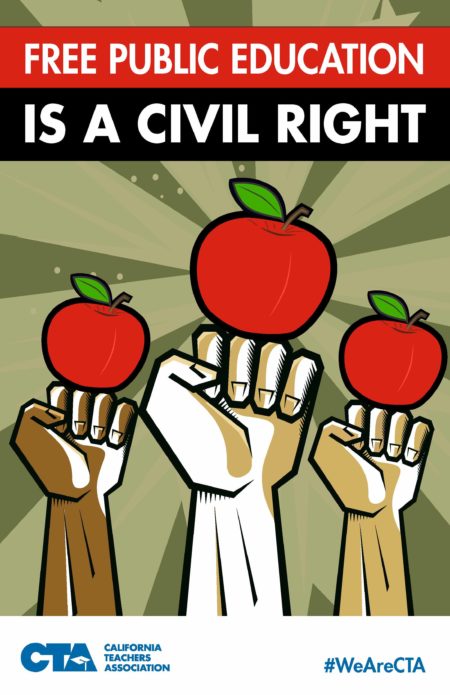
Perhaps the California Teachers Association posters could be juxtaposed with excerpts from the foundational documents of the United States. Students could consider whether the principles in those documents are being fulfilled or are even worthy of fulfillment. For example, an obvious area for discussion would be the First Amendment to the U.S. Constitution:
Congress shall make no law respecting an establishment of religion, or prohibiting the free exercise thereof; or abridging the freedom of speech, or of the press; or the right of the people peaceably to assemble, and to petition the government for a redress of grievances.
A thoughtful student might argue that the California Teachers Association posters undermine the First Amendment. For example, the claim on one classroom poster that “Kindness Is Everything” could be interpreted as a kind of religious principle established by the state. (Change the statement on the poster to “God Is Everything” or “God is Love” and the California Teachers Association would likely object to its display in a public school.)
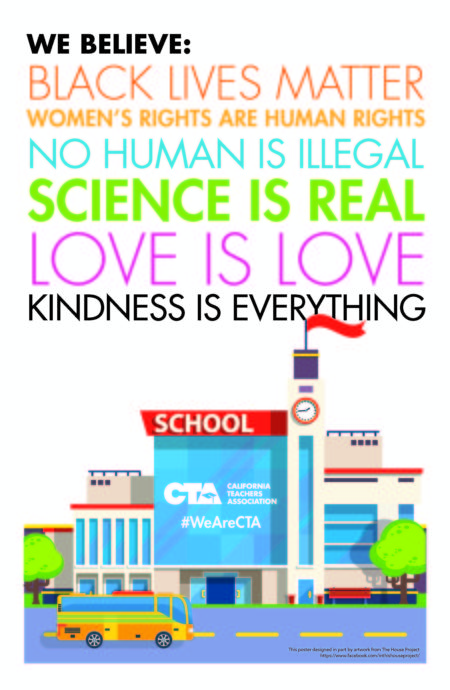
A thoughtful student could also look at a California Teachers Association “Hate-Free Zone” poster and argue that while the sentiment is admirable, its actual institution as a policy is an invitation for totalitarianism. To eliminate hate, the government would need to define hate – including its appearance in thought, art, music, sports, writing and speech – and determine which factions should be disciplined or controlled in order to suppress and eliminate that hate. Meanwhile, the class intellectual provocateur could point out poster paradox and, maybe even citing Bob Dylan, ask if the hatred of hate is allowed in the Hate-Free Zone.
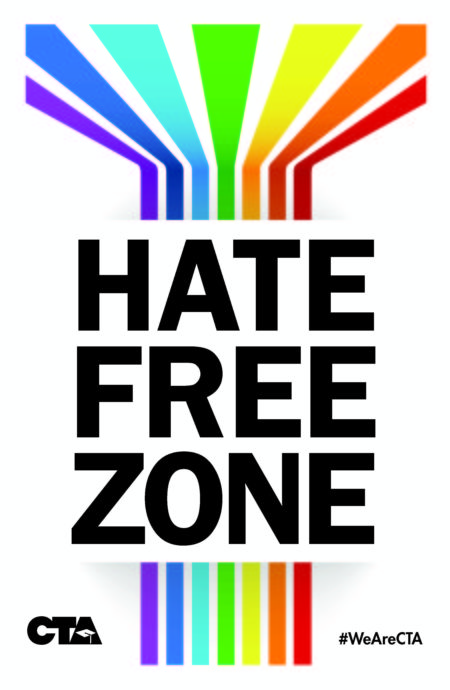
3. Do teachers have the right – as a matter of free speech – to display the California Teachers Association political posters in the classroom? Is displaying the posters a violation of student rights? Parent rights?
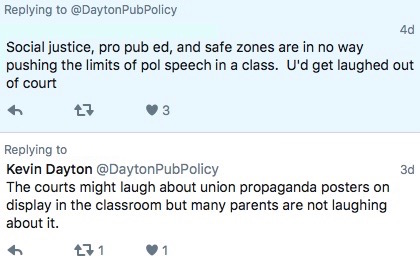
As seen above, a defender of the California Teachers Association posters asserts that anyone who judicially challenged the poster as a violation of student rights would be “laughed out of court.” But is this claim accurate?
The American Civil Liberties Union (ACLU) of Washington State (like California, part of the federal Ninth Circuit court that would likely hear such a case) has produced a comprehensive guide to the free speech rights of teachers in that state. It notes that the government restricts certain speech rights for a K-12 public school teacher:
Generally, the First Amendment protects your speech if you are speaking as a private citizen on a matter of public concern. However, if you are speaking as part of the duties of your job, your speech will not necessarily have the same protection. What you say or communicate inside the classroom is considered speech on behalf of the school district and therefore is not entitled to First Amendment protection. Certain types of speech outside the school might also not be protected if the school can show that your speech created a substantial adverse impact on school functioning or that your speech was made in accordance with your job duties.
It also notes that speech does include “classroom decoration, posters or displays…It is likely that the school could require you to remove political signs from the classroom.”
Students could be encouraged to use the California Teachers Association posters as a case study about the limits of free speech. Are the rights of students violated when they enter a classroom to fulfill their mandatory educational duties and are forced to see these posters as exhibits of “truth” as expounded by the California Teachers Association? Are the rights of teachers violated when they are prevented from displaying such posters in the classroom?
Teach Your Children at Home with California Teachers Association Posters
Obviously, some parents (and some students) may vehemently disagree with the content and connotations of the California Teachers Association posters. Parents and students who disagree with the classroom presence or messages of the California Teachers Association posters may be inclined to exert their perceived rights and try to get the posters removed from classrooms.
But just because a student sees and thinks about these California Teachers Association posters doesn’t mean that student will inevitably adopt those messages as their own irrefutable, self-evident truths. Perhaps the most educational response that parents can provide for their children is to discuss the posters at home in a way that should be done in the classroom. That would require California parents to be engaged in the instruction of their children and aware of the teaching atmosphere in their children’s classrooms. Regrettably, there are no California Teachers Association classroom posters that encourage this kind of educational subversion.
Kevin Dayton, a frequent contributor to CPC’s Prosperity Digest, is the President & CEO of Labor Issues Solutions, LLC, and is the author of frequent postings about generally unreported California state and local policy issues at www.laborissuessolutions.com. Follow him on Twitter at @DaytonPubPolicy.

